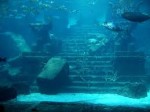World History After Noah – Part II
Conditions for travel by both people and animals were affected by a one time Ice Age, which occurred after the Flood as the results of two unrepeatable conditions. (1) The oceans contained warm water because of widespread exposure to magma, volcanic eruptions, and recently released hot subterranean water. The warm waters easily evaporated and formed clouds, producing massive amounts of snow during the winter months and frequent rains during the summer months.
(2) The summer months were often cooler than usual, because large amounts of volcanic ash in the air from widespread volcanic eruptions blocked the sun’s rays. The cooler temperatures of summer only allowed a partial melting of each year’s winter snows, so ice packs began to build up on the land. The persistence of warm oceans and cool summer temperatures resulted in more and more ice accumulations outside the temperate regions.
